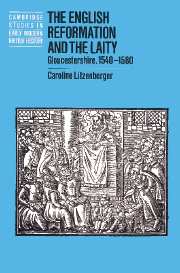Book contents
- Frontmatter
- Contents
- List of figures
- List of tables
- Acknowledgments
- Abbreviations and conventions
- Introduction
- 1 Setting the scene
- 2 Gloucestershire in the 1530s
- 3 The new diocese of Gloucester (1540–1546)
- 4 The advent of Edwardian Protestantism (1547–1553)
- 5 A return to the old religion (1553–1558)
- 6 The early years of Elizabeth's reign (1559–1569)
- 7 The clarification of the religious settlement (1570–1580)
- Conclusion
- Appendix A Sources and methodology
- Appendix B Results of wills analysis
- Appendix C Parish finances
- Bibliography
- Index
- Cambridge Studies in Early Modern British History
5 - A return to the old religion (1553–1558)
Published online by Cambridge University Press: 23 November 2009
- Frontmatter
- Contents
- List of figures
- List of tables
- Acknowledgments
- Abbreviations and conventions
- Introduction
- 1 Setting the scene
- 2 Gloucestershire in the 1530s
- 3 The new diocese of Gloucester (1540–1546)
- 4 The advent of Edwardian Protestantism (1547–1553)
- 5 A return to the old religion (1553–1558)
- 6 The early years of Elizabeth's reign (1559–1569)
- 7 The clarification of the religious settlement (1570–1580)
- Conclusion
- Appendix A Sources and methodology
- Appendix B Results of wills analysis
- Appendix C Parish finances
- Bibliography
- Index
- Cambridge Studies in Early Modern British History
Summary
Our king has been removed from us by reason of our sins, to the very great peril of our church. His sister Mary has succeeded, whom I pray God always to aid by his Holy Spirit, that she may reign and govern in all respects to the glory of his name. The altars are again set up throughout the kingdom; private masses are frequently celebrated in many quarters; the true worship of God, true invocation, the right use of the sacraments, are all done away with; divine things are trodden under foot, and human things have the preeminence. May God be present with his church, for the sake of his only Son Jesus Christ! … In haste, from prison, at London. Sept. 3,1553.
Mary's succession to the throne following Edward VI's death on 6 July 1553 may not have been either automatic or immediate; however, she had claimed the Crown by 19 July. Bishop Hooper, who had supported her despite the future religious implications of her rule, was arrested and committed to the Fleet on 1 September 1553. Two days later he wrote to Henry Bullinger in Zurich to express his fears and prayers for religion in England. Much was changing very quickly, as Mary and her advisors moved to annul the Protestant innovations of the previous twenty years, remove its leading advocates, and restore Catholicism.
Thus, during the first years of Mary's reign there was an abrupt and dramatic swing in official policy from the most reformed version of Protestantism ever embodied in official English religion to a form of Catholicism which would include full restoration of the mass and obedience to the Pope.
- Type
- Chapter
- Information
- The English Reformation and the LaityGloucestershire, 1540–1580, pp. 83 - 103Publisher: Cambridge University PressPrint publication year: 1997



